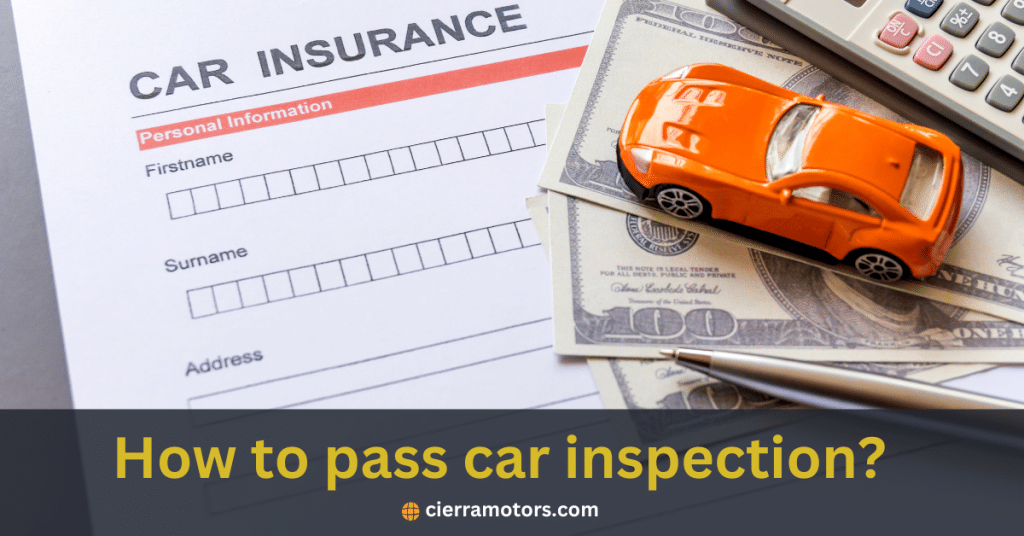Introduction: The Purpose of Car Inspections
Before we dive into the nitty-gritty of how to pass a car inspection, it’s crucial to understand why these assessments are essential. Car inspections ensure that your vehicle complies with state safety and emissions regulations. They exist to keep unsafe and polluting vehicles off the roads and are crucial to maintaining a safe driving environment for everyone.
Pre-Inspection Preparation: The Key to Success

- Car checklist to ensure your vehicle is in good condition
The success of your car inspection starts long before you pull into the inspection station. Here’s a detailed guide to pre-inspection preparation to help make sure you’re ready:
Create a Detailed Checklist
Create a checklist that covers all areas of inspection. Everyday items to include are:
- Lights: Inspect all exterior lights—headlights, taillights, turn signals, and brake lights. Please make sure they’re clean, functional, and aimed correctly.
- Tires: Check tread depth, inflation, and general condition. Replace any tires that are worn or damaged.
- Brakes: Ensure that your brake pads have adequate thickness and are not worn down to the squealer tab.
- Fluids: Top-off or replace fluids as necessary, including oil, coolant, brake fluid, and windshield wiper fluid.
- Documentation: Have your vehicle registration and insurance documents ready to go.
How to deal with vehicle inspection
- Before starting, find out what the test will include. This way, you can address any known issues beforehand.
- Ensure your vehicle is clean inside and out. A dirty engine could mask problems, and a cluttered vehicle might hinder the inspection.
- Remove any accessories, such as bike-share racks, that are not a part of the state’s required equipment list.
- Have your paperwork organized and ready before arriving.
- If necessary, inform the station if your vehicle has recently been serviced or repaired.
During Inspection: Keeping a Cool Head
The day of your inspection can be nerve-wracking, but dealing with the inspectors doesn’t have to be. Here are some tips for during your inspection:
Effective Communication
- Remain calm and polite, even if you receive unwelcome news.
- Once the inspection is underway, communicate any significant issues directly with inspectors. Let them know of any specific concerns you want them to address.
- If you disagree with any findings, ask the inspector to explain their reasoning and refer to the applicable section of the vehicle code if necessary.
Understanding the Process
- Before heading in, understand the steps of the inspection process. This will help you manage expectations and know what to do while you wait.
- Be aware of the potential outcomes of the inspection and understand that the first visit may identify issues that need to be addressed before the car will pass.
Addressing Common Issues: Roadblocks to Passing
It’s not uncommon for inspectors to identify minor issues that can be corrected on the spot. Here are some strategies for dealing with common problems:
How to Pass with a Check Engine Light
- First, determine if it’s an issue that needs immediate attention or one that can be scheduled for repair.
- Get a diagnostic scan to understand the exact issue causing the check engine light. Many auto parts stores offer this service for free.
- If the issue is something you can address, do so and be prepared to drive a set number of miles to reset the car’s internal system before going in for the inspection.
- If the repair is more involved, consider using a certified repair shop. They often provide a warranty on their work, ensuring the issue is resolved.
Resolving Worn-Out Tires and Brakes
- Replace worn-out tires with new ones or tires with sufficient tread depth to pass the inspection.
- If brakes have any signs of wear, have them inspected and replaced if necessary. Good brakes are essential for vehicle safety.
Common Emissions Issues
- If your vehicle fails an emissions test, first check for any misfires or conditions that affect the regular running of the engine.
- If the issue is the catalytic converter, it’s not a DIY fix and will likely require professional help.
- EGR valve issues can often be cleaned rather than replaced, depending on the problem.
Post-Inspection Tips: Understanding the Results
If your car does fail the inspection, don’t panic. Understanding what went wrong is the first step to addressing the issue.
Understanding the Report
- Review the inspection report in detail. Ensure you understand what the test found and what needs fixing.
- Ask the inspector to walk you through the report to ensure you understand the next steps.
- Many inspection stations will reschedule a free re-inspection, especially if the failed items are repaired quickly.
Necessary Next Steps
- Address the issues that caused the failure as a priority. Depending on local regulations, failing to do so may result in fines or other penalties.
- If the issues are beyond your abilities, research certified repair shops in your area that can help. Prepare for the possibility of costs for parts and labor.
Conclusion
Passing your car inspection doesn’t have to be a daunting task. You can ensure your vehicle is safe and compliant on the road with proper preparation, effective communication, and a willingness to fix any issues. Regular maintenance and early detection of issues are critical to a smooth inspection and safe driving. Drive safely!



Leave a comment